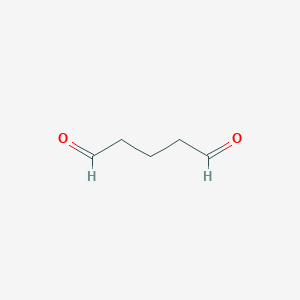| General Information of MET (ID: META00906) |
| Name |
Glutaral
|
| Synonyms |
Click to Show/Hide Synonyms of This Metabolite
1,3-Diformyl propane; 1,3-Diformylpropane; 1,5-Pentanedial; 1,5-Pentanedione; Aldehyd glutarowy; Aldesan; Aldesen; Alhydex; Aqucar; Bactron K31; Bioglan brand OF glutaral; Bode brand OF glutaral; Cahill may roberts brand OF glutaral; Cidex; Cidex 7; Coldcide-25 microbiocide; Dermal brand OF glutaral; Dermatech brand OF glutaral; Dioxopentane; Diswart; Ecolab brand OF glutaral; GLUTARALDEHYDE, 25% soln; Gludesin; Glutaclean; Glutaral; Glutaral(usan); Glutaral, inn, usan; Glutaraldehyd; Glutaraldehyde; Glutaralum; Glutarate dialdehyde; Glutardialdehyde; Glutarex 28; Glutaric acid dialdehyde; Glutaric aldehyde; Glutaric dialdehyde; Glutarol; Glutarol-1,5-pentanedial; Gluteraldehyde; Glutural; Hospex; Johnson and johnson brand OF glutaral; Korsolex; Novaruca; PENTANEDIAL; PTD; Pentane-1,5-dial; Pentanedial, homopolymer; Poly(glutaraldehyde); Polyglutaraldehyde; Potentiated acid glutaraldehyde; Protectol gda, GT 50; Relugan GT; Relugan GT 50; Relugan GTW; Sekumatic; Sonacide; Sporicidin; Sterihyde; Sterihyde L; Ucarcide; Ucarcide 225; Ucarcide 250; Ucarset; Veruca-sep; Verucasep; Virsal
|
| Source |
Endogenous;Food;Carcinogenic Potency;Drug;Agricultural Chemicals;Toxins/Pollutant;Cosmetic;Food additives
|
| Structure Type |
Carbonyl compounds (Click to Show/Hide the Complete Structure Type Hierarchy)
Organic oxygen compounds
Organooxygen compounds
Carbonyl compounds
|
| PubChem CID |
|
| HMDB ID |
|
| Formula |
C5H8O2
|
| Structure |
<iframe style="width: 300px; height: 300px;" frameborder="0" src="https://embed.molview.org/v1/?mode=balls&cid=3485"></iframe>
|
 |
|
3D MOL
|
2D MOL
|
|
Click to Show/Hide the Molecular/Functional Data (External Links/Property/Function) of This Metabolite
|
| KEGG ID |
|
| DrugBank ID |
|
| ChEBI ID |
|
| FooDB ID |
|
| ChemSpider ID |
|
| Physicochemical Properties |
Molecular Weight |
100.12 |
Topological Polar Surface Area |
34.1 |
| XlogP |
-0.5 |
Complexity |
51.1 |
| Heavy Atom Count |
7 |
Rotatable Bond Count |
4 |
| Hydrogen Bond Donor Count |
N.A. |
Hydrogen Bond Acceptor Count |
2 |
| Function |
Glutaral is used as an antimicrobial agent in sugar mills and as a fixing agent in the immobilisation of glucose isomerase enzyme preparations for use in the manufacture of high fructose corn syrup A polymerized isomer of glutaraldehyde known as polycycloglutaracetal is a fertilizer for aquatic plants. It is claimed that it provides a bioavailable source of carbon for higher plants that is not available to algae. Though not marketed as such due to federal regulations, the biocidal effect of glutaraldehyde kills most algae at concentrations of 0.5 - 5.0 ppm. These levels are not harmful to most aquatic fauna and flora. Adverse reactions have been observed by some aquarists at these concentrations in some aquatic mosses, liverworts, and vascular plants. Glutaraldehyde is a colorless liquid with a pungent odor used to disinfect medical and dental equipment. It is also used for industrial water treatment and as a chemical preservative. Glutaraldehyde is an oily liquid at room temperature (density 1.06 g/mL), and miscible with water, alcohol, and benzene. It is used as a tissue fixative in electron microscopy. It is employed as an embalming fluid, is a component of leather tanning solutions, and occurs as an intermediate in the production of certain industrial chemicals. Glutaraldehyde is frequently used in biochemistry applications as an amine-reactive homobifunctional crosslinker. The oligomeric state of proteins can be examined through this application. However, it is toxic, causing severe eye, nose, throat and lung irritation, along with headaches, drowsiness and dizziness. It is a main source of occupational asthma among health care providers
|
|
Regulatory Network
|
|
|
|
|
|
|
|
|
 click to show the details of this protein
click to show the details of this protein
 click to show the details of experiment for validating this pair
click to show the details of experiment for validating this pair

